Page 199 of 344
197
3008_en_Chap09_verifications_ed01-2015
You have exceeded the authorised
driving limit: the starting prevention
system inhibits engine starting.
Starting prevented
Every time the ignition is switched on, the
SERVICE and engine diagnostic warning
lamps come on and the UREA warning lamp
flashes, accompanied by an audible signal and
the display of the message "Emissions fault:
Starting prevented".
Freezing of the AdBlue
® additive
To be able to start the engine, you must call on
a PEUGEOT dealer or a qualified workshop. The AdBlue® additive freezes at
temperatures below around -11°C.
The SCR system includes a heater
for the AdBlue
® tank, allowing you to
continue driving in very cold conditions.
9
Checks
Page 200 of 344
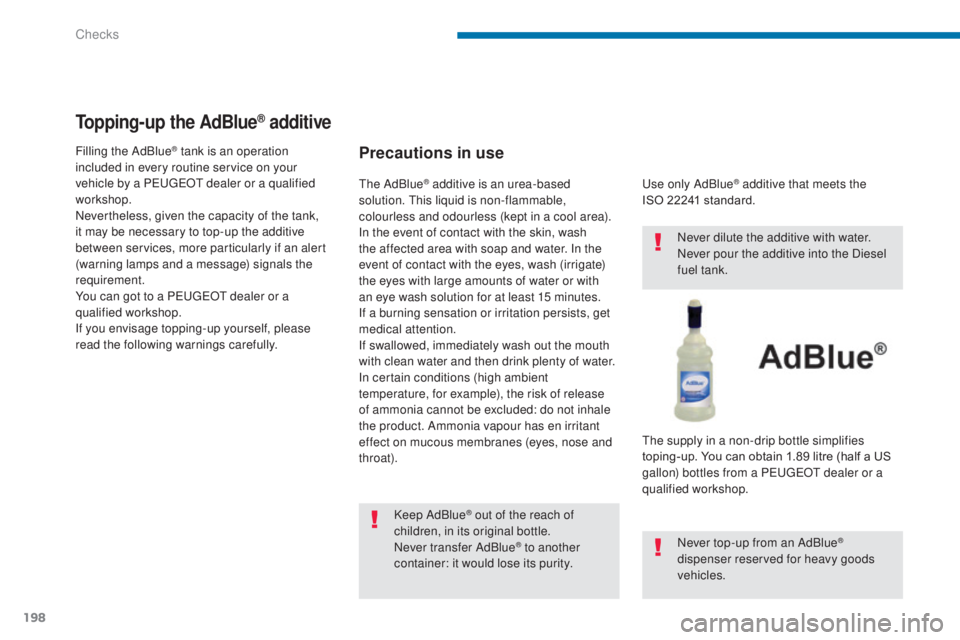
198
3008_en_Chap09_verifications_ed01-2015
Topping-up the AdBlue® additive
Precautions in use
Keep AdBlue® out of the reach of
children, in its original bottle.
Never transfer AdBlue
® to another
container: it would lose its purity. Use only AdBlue
® additive that meets the
ISO
22241 standard.
The AdBlue® additive is an urea-based
solution. This liquid is non-flammable,
colourless and odourless (kept in a cool area).
In the event of contact with the skin, wash
the affected area with soap and water. In the
event of contact with the eyes, wash (irrigate)
the eyes with large amounts of water or with
an eye wash solution for at least 15 minutes.
If a burning sensation or irritation persists, get
medical attention.
If swallowed, immediately wash out the mouth
with clean water and then drink plenty of water.
In certain conditions (high ambient
temperature, for example), the risk of release
of ammonia cannot be excluded: do not inhale
the product. Ammonia vapour has en irritant
effect on mucous membranes (eyes, nose and
throat). Never dilute the additive with water.
Never pour the additive into the Diesel
fuel tank.
The supply in a non-drip bottle simplifies
toping-up. You can obtain 1.89 litre (half a US
gallon) bottles from a PEUGEOT
dealer or a
qualified workshop.
Never top-up from an AdBlue
®
dispenser reserved for heavy goods
vehicles.
Filling the AdBlue
® tank is an operation
included in every routine service on your
vehicle by a PEUGEOT dealer or a qualified
workshop.
Nevertheless, given the capacity of the tank,
it may be necessary to top-up the additive
between services, more particularly if an alert
(warning lamps and a message) signals the
requirement.
You can got to a PEUGEOT dealer or a
qualified workshop.
If you envisage topping-up yourself, please
read the following warnings carefully.
Checks
Page 208 of 344
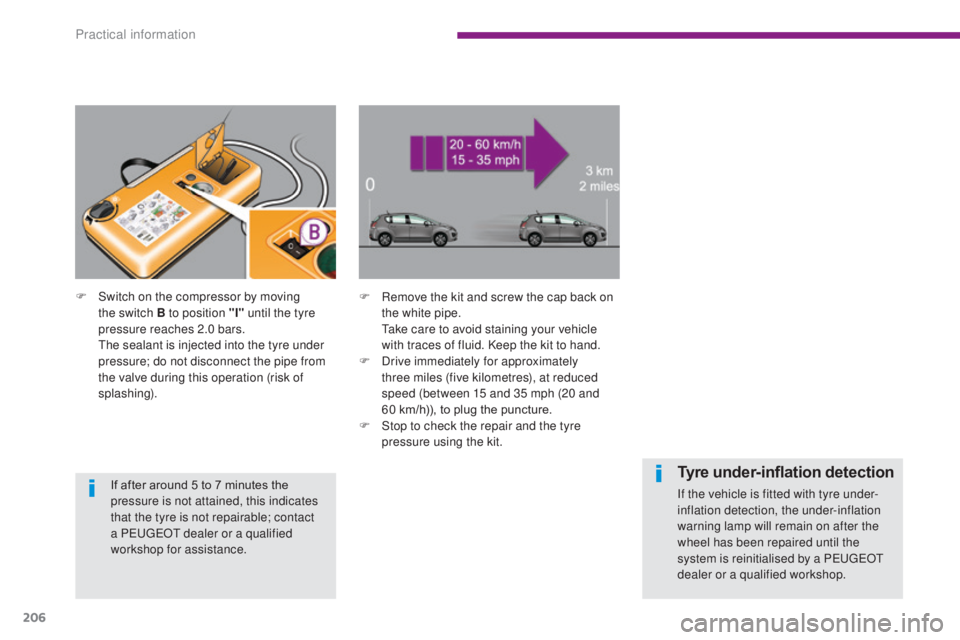
206
3008_en_Chap10_infos-pratiques_ed01-2015
F Remove the kit and screw the cap back on the white pipe.
T
ake care to avoid staining your vehicle
with traces of fluid. Keep the kit to hand.
F
D
rive immediately for approximately
three miles (five kilometres), at reduced
speed (between 15 and 35 mph (20 and
60
km/h)), to plug the puncture.
F
S
top to check the repair and the tyre
pressure using the kit.
F
S
witch on the compressor by moving
the switch B to position "I" until the tyre
pressure reaches 2.0 bars.
T
he sealant is injected into the tyre under
pressure; do not disconnect the pipe from
the valve during this operation (risk of
splashing).
If after around 5 to 7 minutes the
pressure is not attained, this indicates
that the tyre is not repairable; contact
a PEUGEOT dealer or a qualified
workshop for assistance.
Tyre under-inflation detection
If the vehicle is fitted with tyre under-
inflation detection, the under-inflation
warning lamp will remain on after the
wheel has been repaired until the
system is reinitialised by a PEUGEOT
dealer or a qualified workshop.
Practical information
Page 212 of 344
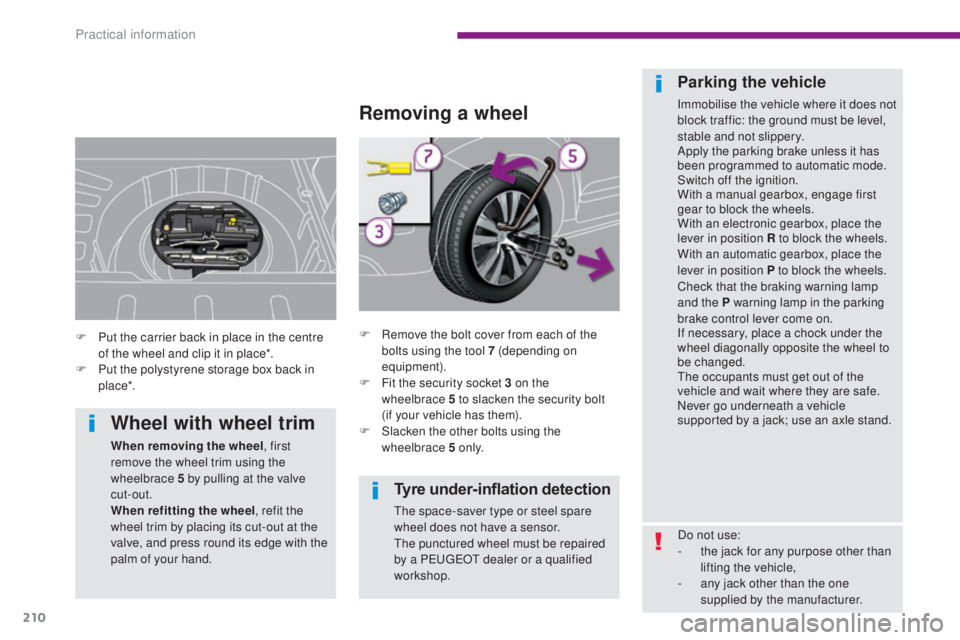
210
3008_en_Chap10_infos-pratiques_ed01-2015
Tyre under-inflation detection
The space-saver type or steel spare
wheel does not have a sensor.
The punctured wheel must be repaired
by a PEUGEOT dealer or a qualified
workshop.
Removing a wheel
F Remove the bolt cover from each of the bolts using the tool 7 (depending on
equipment).
F
F
it the security socket 3 on the
wheelbrace
5 to slacken the security bolt
(if
your vehicle has them).
F
S
lacken the other bolts using the
wheelbrace 5 o n l y.
Parking the vehicle
Immobilise the vehicle where it does not
block traffic: the ground must be level,
stable and not slippery.
Apply the parking brake unless it has
been programmed to automatic mode.
Switch off the ignition.
With a manual gearbox, engage first
gear to block the wheels.
With an electronic gearbox, place the
lever in position R to block the wheels.
With an automatic gearbox, place the
lever in position P to block the wheels.
Check that the braking warning lamp
and the P warning lamp in the parking
brake control lever come on.
If necessary, place a chock under the
wheel diagonally opposite the wheel to
be changed.
The occupants must get out of the
vehicle and wait where they are safe.
Never go underneath a vehicle
supported by a jack; use an axle stand.
F
P
ut the carrier back in place in the centre
of the wheel and clip it in place*.
F
P
ut the polystyrene storage box back in
p lac e*.
Wheel with wheel trim
When removing the wheel , first
remove the wheel trim using the
wheelbrace 5 by pulling at the valve
cut-out.
When refitting the wheel , refit the
wheel trim by placing its cut-out at the
valve, and press round its edge with the
palm of your hand. Do not use:
-
t
he jack for any purpose other than
lifting the vehicle,
-
a
ny jack other than the one
supplied by the manufacturer.
Practical information
Page 226 of 344
224
3008_en_Chap10_infos-pratiques_ed01-2015
Fuse N° Rating
(A) Functions
F30 5Heated door mirrors.
F31 30Boot 12 V socket.
F32 5Electronic gearbox gear lever.
F33 10Head-up display, Bluetooth system, air conditioning.
F34 5Seat belt warning lamp display.
F35 10Parking sensors, Hi-Fi amplifier authorisation.
F36 10Trailer fusebox control unit, driver's door control pad.
F37 20Hi-Fi amplifier.
F38 30Driver's electric seat.
F39 20Panoramic sunroof blind.
Practical information
Page 235 of 344
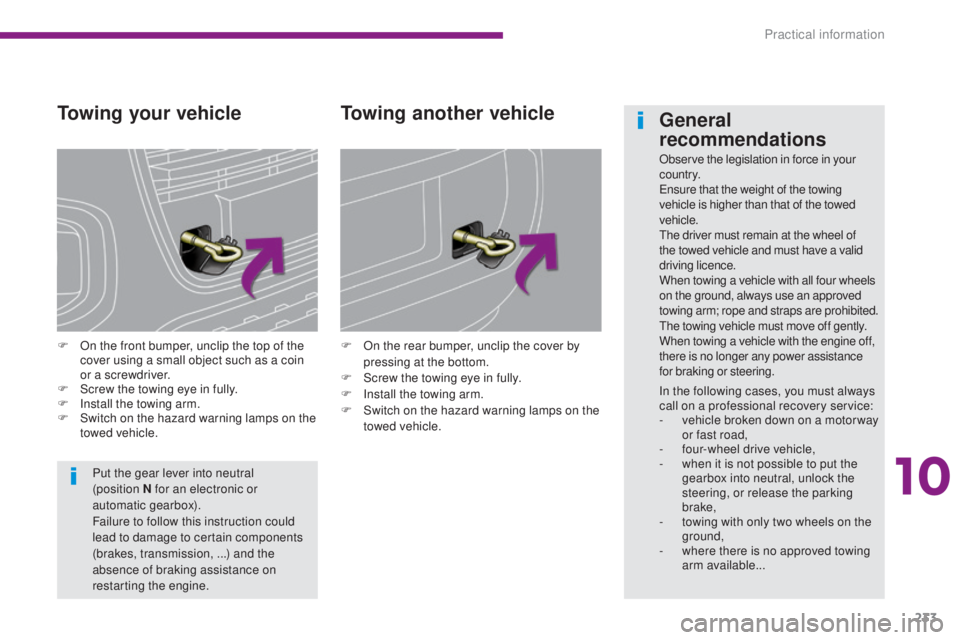
233
3008_en_Chap10_infos-pratiques_ed01-2015
Towing your vehicle
F On the front bumper, unclip the top of the cover using a small object such as a coin
or a screwdriver.
F
S
crew the towing eye in fully.
F
I
nstall the towing arm.
F
S
witch on the hazard warning lamps on the
towed vehicle. F
O n the rear bumper, unclip the cover by
pressing at the bottom.
F
S
crew the towing eye in fully.
F
I
nstall the towing arm.
F
S
witch on the hazard warning lamps on the
towed vehicle.
Towing another vehicle
Put the gear lever into neutral
(position N for an electronic or
automatic gearbox).
Failure to follow this instruction could
lead to damage to certain components
(brakes, transmission, ...) and the
absence of braking assistance on
restarting the engine.
General
recommendations
Observe the legislation in force in your
c o unt r y.
Ensure that the weight of the towing
vehicle is higher than that of the towed
vehicle.
The driver must remain at the wheel of
the towed vehicle and must have a valid
driving licence.
When towing a vehicle with all four wheels
on the ground, always use an approved
towing arm; rope and straps are prohibited.
The towing vehicle must move off gently.
When towing a vehicle with the engine off,
there is no longer any power assistance
for braking or steering.
In the following cases, you must always
call on a professional recovery service:
-
v
ehicle broken down on a motor way
or fast road,
-
f
our-wheel drive vehicle,
-
w
hen it is not possible to put the
gearbox into neutral, unlock the
steering, or release the parking
brake,
-
t
owing with only two wheels on the
ground,
-
w
here there is no approved towing
arm available...
10
Practical information
Page 239 of 344

237
3008_en_Chap10_infos-pratiques_ed01-2015
Side wind
F Take into account the increased sensitivity to side wind.
Cooling
Towing a trailer on a slope increases the
temperature of the coolant.
As the fan is electrically controlled, its cooling
capacity is not dependent on the engine speed.
F
T
o lower the engine speed, reduce your
speed.
The maximum towed load on a long incline
depends on the gradient and the ambient
temperature.
In all cases, keep a check on the coolant
temperature.
Braking
Towing a trailer increases the braking distance.
To avoid overheating of the brakes on a long
mountain type of descent, the use of engine
braking is recommended.
Ty r e s
F Check the tyre pressures of the towing vehicle and of the trailer, observing the
recommended pressures.
Lighting
F Check the electrical lighting and signalling on the trailer.
The rear parking sensors will be
deactivated automatically if a genuine
PEUGEOT towbar is used.
F
I
f the warning lamp and the STOP
warning lamp come on, stop the
vehicle and switch off the engine
as soon as possible.
10
Practical information
Page 242 of 344
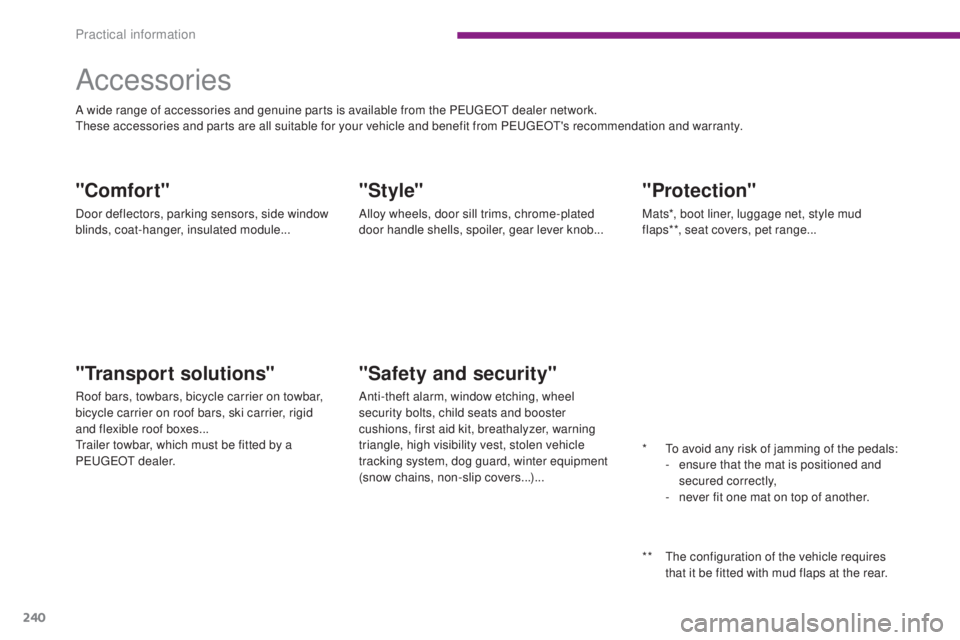
240
3008_en_Chap10_infos-pratiques_ed01-2015
Accessories
"Comfort"
Door deflectors, parking sensors, side window
blinds, coat-hanger, insulated module...
"Transport solutions"
Roof bars, towbars, bicycle carrier on towbar,
bicycle carrier on roof bars, ski carrier, rigid
and flexible roof boxes...
Trailer towbar, which must be fitted by a
PEUGEOT dealer.
"Style"
Alloy wheels, door sill trims, chrome-plated
door handle shells, spoiler, gear lever knob...
"Safety and security"
Anti-theft alarm, window etching, wheel
security bolts, child seats and booster
cushions, first aid kit, breathalyzer, warning
triangle, high visibility vest, stolen vehicle
tracking system, dog guard, winter equipment
(snow chains, non-slip covers...)...
"Protection"
Mats*, boot liner, luggage net, style mud
flaps**, seat covers, pet range...
A wide range of accessories and genuine parts is available from the PEUGEOT dealer network.
These accessories and parts are all suitable for your vehicle and benefit from PEUGEOT's recommendation and warranty.
**
T
he configuration of the vehicle requires
that it be fitted with mud flaps at the rear.
*
T
o avoid any risk of jamming of the pedals:
-
e
nsure that the mat is positioned and
secured correctly,
-
n
ever fit one mat on top of another.
Practical information